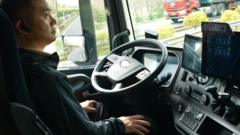As test runs for autonomous trucks gain traction in China, industry experts highlight their potential to transform transportation by reducing costs and improving safety, although public skepticism and technical hurdles remain significant challenges.**
Revolutionizing Transport: The Rise of Autonomous Trucks in China**

Revolutionizing Transport: The Rise of Autonomous Trucks in China**
China's roadways are witnessing a technological revolution as driverless trucks transition from testing to broader applications, promising efficiency and safety in logistics.**
On the highways linking Beijing and Tianjin, a new era in transport is unfolding with driverless trucks, technology that’s poised to redefine logistics in China. Despite current regulations requiring a safety driver, the vehicles are equipped to navigate autonomously, showcasing their capability to operate without human intervention.
Huo Kangtian, a safety driver, illustrates the gradual shift towards autonomy as he relinquishes control to the truck, admitting a mix of awe and apprehension. The transition from manual to autonomous driving offers relief from fatigue and a chance to engage in other tasks, yet Huo maintains a cautious outlook regarding job security amidst technological advancement.
Li Hengyu, vice-president of Pony AI, underscores that the future entails enhanced transportation efficiency with automated vehicles. He forecasts reduced labor costs and improved performance, particularly during extended logistical operations or adverse conditions. Yang Ruigang, a technology professor, echoes this sentiment, emphasizing the financial motivations steering companies towards driverless innovations, with the ultimate objective of minimizing driver costs.
However, substantial public concerns linger, particularly after incidents related to autonomous technology, such as a tragic accident causing fatalities. Chim Lee from the Economist Intelligence Unit signals the need for a cultural shift in China, where public perception of self-driving trucks plays a critical role in policy developments and market acceptance.
In Hefei, Anhui Province, the scene is more promising, with driverless delivery vans navigating urban environments amidst bustling traffic. Gary Huang, president of Rino.ai, notes the synergy between automation and human-driven logistics, facilitating efficient parcel deliveries. With over 500 autonomous vehicles already serving various cities in China, change is evidently in motion.
Despite these strides, obstacles remain—technical improvements are necessary for navigating complex road conditions, and public confidence is paramount to overcoming skepticism surrounding self-driving technology. Yang predicts broader rollouts in low-speed, controlled environments, while other proponents remain optimistic about the imminent integration of driverless vehicles in logistical operations.
As discussions surrounding safety, regulation, and technological reliability continue, China's commitment to innovation positions it at the forefront of autonomous vehicle development. The road ahead offers both challenges and opportunities as the nation aims to embrace automation while addressing societal implications and public concerns. The journey to a fully autonomous transport future, though complex, is undeniably underway.



















